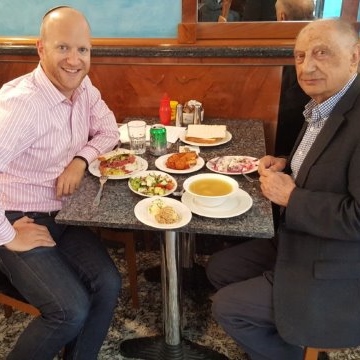
SA

From the old Arcadians for the new
ROBYN SASSEN
Tears of joy come to her eyes as she speaks of the new Arcadia, Johannesburg Jewry’s children’s home, a facility in existence for over 100 years, which has just launched its sixth manifestation in the suburb of Sandringham.
“When I received the video of it on my computer, I watched it again and again. I woke up in the night to watch it again.
“But to actually see it in real life… I was on such a high! It was indescribable. When I met the architect, Mark Falconer, I told him it is miraculous. It’s only on one acre, but the design with its details, is mind-boggling.”
She attended the recent donor opening of Arcadia’s brand new, purpose-designed premises. It was the culmination of over four years’ work. This 20-roomed home, designed with the most sustainable amenities our world can offer, beggars comparison with popular clichés of Victorian orphanages. It’s a place with real values. But it could never have come into existence without help.
That help was forthcoming in part from Monty Koppel, Freda’s brother.
In 1936, Freda, Monty and their parents and five siblings arrived from Czechoslovakia. They were chassidic and poor. Four years later, their mother died; their father could not raise them alone. He faced the hardest decision a parent could: to put his three youngest, Freda, Monty and Hymie, into an orphanage.
Freda, who now lives on Australia’s Gold Coast, is two years older than Monty. Born in 1927, she was in Johannesburg for the launch: “We lived in a small village called Teresva – today in western Ukraine – on the Carpathian Mountains. There was no electricity or running water.
“The journey between Europe and Africa in the 1930s was an ordeal. We didn’t speak English, we were afraid to eat anything as it may not have been kosher, and we spent most of the trip seasick.
“My father was a cigarette salesman; he carried his stock on the trams. He would come home after nine o’clock at night to find us three huddled together in bed, the maid was drunk downstairs; we were frightened. He had to do the cooking, making sure it was kosher… The best thing was to place us in care.
“Who had ever seen such a place! It was palatial!” she refers to Arcadia’s majestic building, on Oxford Road, with its grand staircases and its flow of architectural space, that still today, bisected by the highway, and repurposed as insurance offices, is magnificent.
It was like chalk and cheese from their humble abode in lowly Vrededorp, Johannesburg.
“The children in the orphanage – there were about 300 at the time – were friendly because they were curious about us,” she remembers. “They knew we were religious and spoke no English. But we all played together.
“It was 30 acres. We had great fun in the huge garden and stealing fruit from the Oppenheimers’ estate. We got sandwiches for school – and food was supplied by the government. We went to Forest Town School.”
The Koppel children stayed in Arcadia for four years. Freda and Monty moved home briefly, to live with their father and his new wife and shortly thereafter they moved out, to establish their own lives.
Freda’s Arc years were happy. She recalls the privilege of sleeping on the Arc’s “Romeo and Juliet” balcony. Ma and Doc Lichtigfeld ran the institution at the time; Freda remembers them fondly. She acknowledges how the stakes have changed for children in contemporary orphanages and they are mostly there for different reasons.
The launch of the new building in Sandringham, saw Saul Tomson, the joint group chief executive of the Chevrah Kadisha and a driving force behind the new Arcadia, take the Koppels to visit the orphanage’s former premises, now an insurance consortium.
Arcadia’s history stretches way beyond these two buildings. The first was a small house repurposed in 1903 to cater to eight Jewish orphans in Hillbrow and to take them out of Nazareth House, which was Catholic.
Three years later, it was moved to a house in Kensington. The orphanage moved to Villa Arcadia in Oxford Road in 1923. It became the sanctuary of the so-called Ochberg orphans, and its need for space grew.
Designed by renowned architect Herbert Baker, Villa Arcadia had been the residence of Lady and Lord Lionel Phillips, magnates and philanthropists who sowed many seeds of Johannesburg, from 1909.
They sold it to the Johannesburg Jewish community in 1923 and the original name of this Villa Arcadia, with its resonances of classical utopia, stuck in its being associated with Johannesburg Jewry’s orphans.
“For me, the story’s been a dream,” Tomson said. “This was history in the making. When did this community last build a facility from the ground? Sure, we’ve got nice kosher restaurants and lovely shuls. There’re not really new schools, maybe a classroom or two, but to build an organisation from the ground, for a community that’s just trying to survive, I thought was a phenomenal piece of history. I really wanted everyone to be a part of it.”
The Chev has been running Arcadia since 2003 and three weeks ago, the children moved into their new home.




